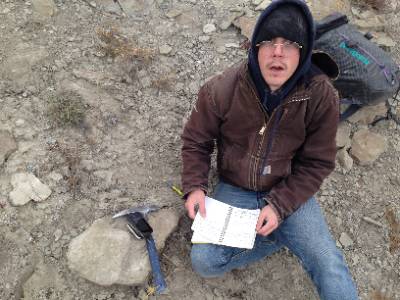Giulio Panascí
Degrees Held
B.S. Sapienza University of Rome, 2010
M.S Sapienza University of Rome, 2013
Degree Sought
PhD Earth Sciences
Advisor:
Dr. David J. Varricchio
Research Project:
Vertebrate ichnology and sedimentology of the non-marine Frontier Formation of southwestern Montana.
Preferred Email Address:
Research and Professional Experience:
Courses Taught
- Assistant librarian, Department of Earth Sciences, Sapienza-University of Rome, (2011-2013)
- Vertebrate Comparative Anatomy Laboratory; Montana State University- Bozeman (2017, 2018)
- Vertebrate Paleontology Laboratory Montana State University- Bozeman (2018)
- Invertebrate Paleontology Laboratory Montana State University- Bozeman (2018)
- Earth Sciences Laboratory Montana State University- Bozeman (2019)
- Invertebrate Paleontology Montana State University- Bozeman (2020)
- Introduction to Chemistry Laboratory Montana State University-Bozeman (2020)
Publications and Presentations:
Peer-reviewed publications
Panascí, G., Varricchio, D.J. and Hirayama, R., 2020, New occurrence of Neurankylus sp.(Testudines: Paracryptodiria: Baenidae) in the Upper Cretaceous Frontier Formation of south western Montana (USA). Cretaceous Research, 108, p.104318.
Panascí, G. and Varricchio, D.J., 2020. A new terrestrial trace fossil Feoichnus martini n. isp. from the Upper Cretaceous Two Medicine Formation (USA). Journal of Paleontology, pp.1-9.
Conference Presentations
Panascì, G, Varricchio, J. D., Martin, J. A. First Occurrence of Pallichnus dakotensis in a Dinosaur Nesting Site from the Two Medicine Formation (Campanian, Upper Cretaceous) of North America. Ichnia 2016: abstract book. UNESCO Geopark Naturtejo/International lchnological Association, Castelo Branco, 88-89
Panascì, G, Varricchio J. D. Dinosaur footprints from the Coniacian Frontier Formation
deposits of
southwestern Montana. Journal of Vertebrate Paleontology, SVP Program and Abstracts
Book 2018
WJ Freimuth, DJ Varricchio, G Panascì Craigslist, ESA 2019: entomologists wanted to identify fossil cocoons, pupae, and other traces from a Cretaceous dinosaur nesting locality (Montana, USA) - Entomology 2019.
